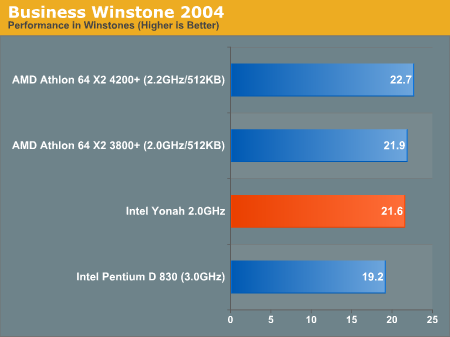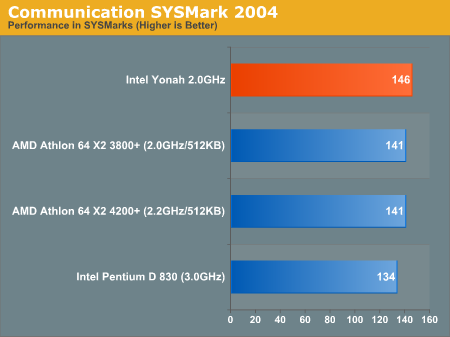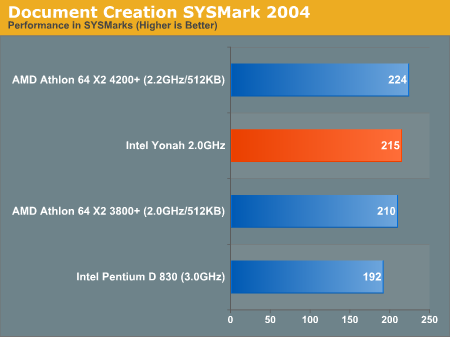Intel Yonah Performance Preview - Part I: The Exclusive First Look at Yonah
by Anand Lal Shimpi on November 30, 2005 2:50 AM EST- Posted in
- CPUs
The Test
Our test configuration is identical to what we used in our Athlon 64 X2 3800+ review, however we can’t disclose the motherboard used for the Yonah platform. We can say that it used the Intel 945G chipset and was outfitted with 2 x 512MB DDR2-533 DIMMs; the rest of the configuration remained the same as the AMD and Intel systems.
Once again, keep in mind that the platform and processor are pre-release samples, and performance could change by the time the parts head to retail. This is nothing more than a preview, so treat it as such.
Business Winstone 2004
Business Winstone 2004 tests the following applications in various usage scenarios:
. Microsoft Access 2002
. Microsoft Excel 2002
. Microsoft FrontPage 2002
. Microsoft Outlook 2002
. Microsoft PowerPoint 2002
. Microsoft Project 2002
. Microsoft Word 2002
. Norton AntiVirus Professional Edition 2003
. WinZip 8.1

Just as we saw in the Dothan vs. Yonah tests, Yonah loses some of its competitive edge in the Business Winstone benchmark. Although in this case, it's not very far off the Athlon 64 X2 3800+.
Office Productivity SYSMark 2004
SYSMark's Office Productivity suite consists of three tests, the first of which is the Communication test. The Communication test consists of the following:
"The user receives an email in Outlook 2002 that contains a collection of documents in a zip file. The user reviews his email and updates his calendar while VirusScan 7.0 scans the system. The corporate web site is viewed in Internet Explorer 6.0. Finally, Internet Explorer is used to look at samples of the web pages and documents created during the scenario."

Yonah manages to be quite competitive in the SYSMark tests, slightly outpacing the Athlon 64 X2 4200+ here.
The next test is Document Creation performance, which shows very little difference in drive performance between the contenders:
"The user edits the document using Word 2002. He transcribes an audio file into a document using Dragon NaturallySpeaking 6. Once the document has all the necessary pieces in place, the user changes it into a portable format for easy and secure distribution using Acrobat 5.0.5. The user creates a marketing presentation in PowerPoint 2002 and adds elements to a slide show template."

Here we see that at 2.0GHz, Intel's Yonah is right in the middle of AMD's Athlon 64 X2 4200+ and the X2 3800+. Given that the CPU has no on-die memory controller, yet performs comparably to an identically clocked Athlon 64 X2, it's not a bad position to be in for Yonah.
The final test in our Office Productivity suite is Data Analysis, which BAPCo describes as:
"The user opens a database using Access 2002 and runs some queries. A collection of documents are archived using WinZip 8.1. The queries' results are imported into a spreadsheet using Excel 2002 and are used to generate graphical charts."

The Data Analysis test is dominated by the Pentium D, but even the Athlon 64 X2 3800+ holds a slight advantage over the 2.0GHz Yonah.










135 Comments
View All Comments
edwardhchan - Wednesday, November 30, 2005 - link
For those who care, this is probably the chip that will make it into the Macs next year. Drooling over a new powerbook that dualboots....bldckstark - Wednesday, November 30, 2005 - link
I suppose you will be drowning yourself when you start dreaming of a triple boot with the GoogleOS? On Cell processors? With SkyFi wireless bouncing signals off of the moon (system outage during new moon transition)?Dreams of vaporware let you down more often than a topless dancer when you run out of ones.
I do however often dream about my robotically driven car so that I may play PC games from the back seat on my 60" OLED TV during the drive to work. Imagine internet access on the road then. All the mobile PRON. Gives a new meaning to the word carjack doesn't it?
dougSF30 - Wednesday, November 30, 2005 - link
and on the next generation process.So really, one could say it this way:
AMD's IMC allows their 90nm DC part with 1/2 to 1/4 the L2 cache to perform better than Intel's new 65nm part running at the same clock speed.
fitten - Thursday, December 1, 2005 - link
Only fanbois would say that (or folks who just don't know about computer architectures).a) The AMD Athlon64 has a faster FPU than the Yonah. Benchmarks doing heavy FPU will do better aon the Athlon64.
2) The Athlon64 has more memory bandwidth available to it than the Yonah. While chipsets for Yonah are dual channel, the chip itself still seems to be single channel (like it's predecessors - for power reasons). This configuration does give better performance than all single channel but it isn't as good as all dual channel.
D) Despite these two disadvantages (there are a few others), Yonah still manages to stay close to the Athlon64 parts on average. Some benchmarks it's actually a little faster and some it's a fair bit slower.
One of the best unsung things about the Athlon64 X2s is that a single core Athlon64 only benefits marginally in real benchmarks with dual channel memory compared to single channel memory (ignore synthetic benchmarks). The best I've seen is 20% faster but it is typically on the order of 7% faster. This means that adding a second core, which can double the bandwidth requirements to main memory in really bad situations, can be almost completely satisfied by dual channel. Using the best cases above, the benchmark would need 1.20x the bandwidth of single channel, so this same with a dual core would need 2.4x single channel bandwidth. That's only lacking by 20%.
Compare this to the Pentium4 which gets very large speedups (60% or more sometimes) from dual channel over single channel. Two of those cores doing that would need 3.2x single channel, but dual channel only gives 2.0x meaning that the Pentium4 dual core may have a deficit of 60% of the bandwidth needed to run both cores full-tilt.
Leper Messiah - Thursday, December 1, 2005 - link
But what does the above have to do with Yonah's performance. Architecturally, Yonah is far closer to K8 than to netburst. It should have more than enough bandwidth provided with the "667" FSB, esp. if its dual channel.Anemone - Wednesday, November 30, 2005 - link
I'd agree, the basic core of the A64 chip is quite superior to the P-M, meaning when you take out the cache factor (remember that also applies to programs whose requirements exceed the 2M cache as well so think ahead on that).And yes someone mentioned power requirements going up for Merom - which might require a moderating of clockspeeds to keep it in check in the mobile arena.
Basically for AMD and Nvidia a big opportunity exists here to deliver (and deliver soon) the M2 and take advantage of a very good, but not superb chip from Intel. It remains to be seen if that can be done.
Yonah is good, and would have been great if it had delivered when originally promised (Aug 05, from very early roadmaps), however it is not stellar. But as an overall mobile platform is is the current best. Kudos Intel.
dougSF30 - Wednesday, November 30, 2005 - link
And as far as power goes, Intel admitted that 64-bit would've pushed the power way up on Yonah, so you need to consider that when looking at Yonah TDP vs. X2 TDP.Amagus - Wednesday, November 30, 2005 - link
I'm assuming the load tests were for both cores being fully stressed. What I would have like to have seen were power numbers on a similarly configured Dothan desktop. That would give us a better idea of how expensive that 2nd core is and how good Intel's 65nm process is.
-Amagus
phaxmohdem - Wednesday, November 30, 2005 - link
Well, I'm fairly impressed with this chip personally. It's definately not the "spooge your pants" object of Techno-Lust many of us were hoping for, but as a man truely impressed with the performance of his Banias Pentium M 1.6GHZ CPU, I can only imagine how awesome that 2.0 Dually would be in a laptop.If Conroe can pull off slightly better performance per clock + higher clock speeds + add an integrated Mem/PCIe controller.... We might see some good shiznat in the year to come.
NullSubroutine - Wednesday, November 30, 2005 - link
Intel at least has something to offer if you want a decent notebook. I think it all comes down to cost. It probably wont be as equally fast as an AMD dual core Turion, but if it costs alot more, the whole "less power" really doesnt sell me on the extra money I would have to spend for the entire Intel setup.The product is a decent product, it doesnt blow you away, but it is something that you can get in a new system and not be disappointed (unless you encode/decode). I personally plan to buy a dual core laptop sometime at the end of spring, if the price is right, then it might be what I am getting (unless they produce that Monroe by then).